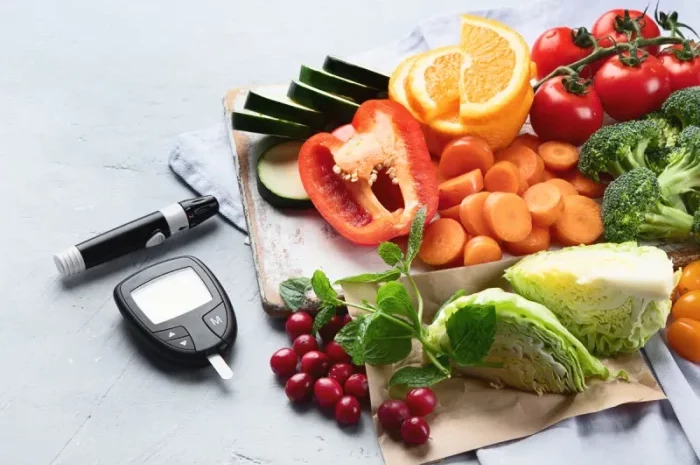Diabetes, particularly type 2 diabetes, is a chronic condition that has reached epidemic proportions worldwide. However, it is also largely preventable through lifestyle changes, particularly dietary modifications. In this comprehensive article, we will explore the foods and dietary patterns that can help prevent diabetes, offering evidence-based recommendations for a healthier future.
Understanding Diabetes
Before delving into preventive dietary strategies, it’s important to understand what diabetes is and how it develops. Diabetes mellitus is a metabolic disorder characterized by high blood sugar levels over a prolonged period. It can occur due to either inadequate insulin production (type 1 diabetes) or insulin resistance (type 2 diabetes). Type 2 diabetes is more common, accounting for about 90-95% of all diabetes cases.
The Role of Insulin and Blood Sugar
Insulin is a hormone produced by the pancreas that allows cells to absorb glucose (sugar) from the bloodstream for energy. In type 2 diabetes, cells become resistant to insulin, leading to higher blood glucose levels. Over time, this can result in serious complications, including heart disease, nerve damage, kidney failure, and vision problems.
Risk Factors for Type 2 Diabetes
Several factors increase the risk of developing type 2 diabetes, including genetics, age, obesity, physical inactivity, and poor dietary habits. Among these, diet is a modifiable risk factor that can significantly influence the development of diabetes.
The Importance of a Balanced Diet
A balanced diet plays a crucial role in preventing type 2 diabetes. It helps maintain healthy blood sugar levels, supports weight management, and reduces the risk of insulin resistance. The following sections will outline specific dietary components and patterns that are beneficial in preventing diabetes.
Foods and Nutrients That Help Prevent Diabetes
1. High-Fiber Foods
Dietary fiber is an essential nutrient for blood sugar control and overall health. Fiber slows the absorption of sugar, preventing spikes in blood glucose levels. There are two types of fiber: soluble and insoluble. Both types are beneficial, but soluble fiber, in particular, helps to regulate blood sugar.
Sources of Soluble Fiber:
- Oats
- Beans and legumes
- Apples
- Citrus fruits
- Carrots
Sources of Insoluble Fiber:
- Whole grains
- Nuts
- Seeds
- Vegetables like broccoli and cauliflower
Increasing fiber intake can also promote satiety, helping with weight management, which is a critical factor in diabetes prevention.
2. Whole Grains
Unlike refined grains, whole grains retain all parts of the grain kernel, including the bran, germ, and endosperm. This means they have more nutrients and fiber. Consuming whole grains instead of refined grains has been associated with a lower risk of developing type 2 diabetes.
Examples of Whole Grains:
- Brown rice
- Quinoa
- Barley
- Whole wheat
- Oats
- Bulgur
Whole grains have a lower glycemic index (GI) than refined grains, meaning they cause a slower, more gradual increase in blood sugar levels.
3. Healthy Fats
Incorporating healthy fats into your diet can improve insulin sensitivity and reduce inflammation. Monounsaturated and polyunsaturated fats are considered healthy fats.
Sources of Healthy Fats:
- Olive oil
- Avocados
- Nuts (almonds, walnuts)
- Seeds (chia seeds, flaxseeds)
- Fatty fish (salmon, mackerel, sardines)
Omega-3 fatty acids, a type of polyunsaturated fat found in fatty fish, flaxseeds, and walnuts, have been shown to reduce inflammation and improve insulin sensitivity.
4. Lean Proteins
Protein is crucial for building and repairing tissues, and it also has a minimal impact on blood sugar levels. Including lean proteins in your diet can help maintain muscle mass, especially when combined with regular physical activity.
Sources of Lean Proteins:
- Poultry (chicken, turkey)
- Fish and seafood
- Eggs
- Low-fat dairy products (Greek yogurt, cottage cheese)
- Plant-based proteins (beans, lentils, tofu, tempeh)
5. Non-Starchy Vegetables
Non-starchy vegetables are low in calories and carbohydrates but high in vitamins, minerals, and fiber. They can be consumed in larger quantities without significantly impacting blood sugar levels.
Examples of Non-Starchy Vegetables:
- Leafy greens (spinach, kale)
- Cruciferous vegetables (broccoli, Brussels sprouts)
- Bell peppers
- Tomatoes
- Cucumbers
- Zucchini
6. Fruits
While fruits contain natural sugars, they also provide essential nutrients and fiber. Choosing whole fruits over fruit juices or dried fruits is important, as whole fruits have a lower GI and higher fiber content.
Low-GI Fruits:
- Berries (strawberries, blueberries, raspberries)
- Apples
- Pears
- Oranges
- Peaches
- Plums
7. Low-Fat Dairy
Low-fat dairy products can be part of a diabetes-prevention diet. They provide calcium, vitamin D, and protein without the high levels of saturated fat found in full-fat dairy.
Examples of Low-Fat Dairy Products:
- Skim milk
- Low-fat yogurt
- Reduced-fat cheese
8. Legumes
Legumes are nutrient-dense and have a low GI, making them excellent for blood sugar control. They are also high in protein and fiber.
Examples of Legumes:
- Beans (black beans, kidney beans)
- Lentils
- Chickpeas
- Peas
9. Nuts and Seeds
Nuts and seeds provide healthy fats, protein, and fiber, all of which can help regulate blood sugar levels and improve insulin sensitivity.
Examples of Nuts and Seeds:
- Almonds
- Walnuts
- Chia seeds
- Flaxseeds
- Pumpkin seeds
10. Spices and Herbs
Certain spices and herbs have been shown to have anti-inflammatory and blood sugar-lowering properties.
Beneficial Spices and Herbs:
- Cinnamon
- Turmeric
- Ginger
- Garlic
- Fenugreek
11. Green Tea
Green tea contains antioxidants called catechins, which have been shown to improve insulin sensitivity and reduce blood sugar levels.
Dietary Patterns for Diabetes Prevention
Beyond individual foods, overall dietary patterns play a significant role in diabetes prevention. Here are some evidence-based dietary patterns that are beneficial:
1. Mediterranean Diet
The Mediterranean diet emphasizes whole grains, fruits, vegetables, legumes, nuts, seeds, and olive oil, with moderate consumption of fish and poultry. This diet is rich in healthy fats, fiber, and antioxidants, all of which contribute to better blood sugar control and reduced inflammation.
2. DASH Diet
The Dietary Approaches to Stop Hypertension (DASH) diet focuses on reducing sodium intake and increasing the consumption of fruits, vegetables, whole grains, and low-fat dairy. It also includes lean proteins and nuts. The DASH diet has been shown to improve blood pressure and insulin sensitivity.
3. Plant-Based Diets
Plant-based diets, which emphasize whole, unprocessed plant foods, have been associated with a lower risk of type 2 diabetes. These diets are high in fiber, antioxidants, and healthy fats, and low in saturated fat and cholesterol.
4. Low-Carbohydrate Diets
Low-carbohydrate diets can help reduce blood sugar levels and improve insulin sensitivity by limiting the intake of high-GI foods. These diets typically emphasize protein and healthy fats while reducing carbohydrates, particularly refined ones.
5. Intermittent Fasting
Intermittent fasting involves cycling between periods of eating and fasting. Some studies suggest that intermittent fasting can improve insulin sensitivity and aid in weight management, both of which are beneficial for diabetes prevention.
Practical Tips for Implementing a Diabetes-Preventive Diet
Transitioning to a diabetes-preventive diet involves making sustainable changes to your eating habits. Here are some practical tips to help you get started:
1. Plan Your Meals
Planning meals in advance can help ensure you incorporate a variety of nutrient-dense foods. Create a weekly meal plan that includes plenty of vegetables, whole grains, lean proteins, and healthy fats.
2. Cook at Home
Cooking at home allows you to control the ingredients and portion sizes of your meals. Experiment with healthy recipes that feature diabetes-preventive foods.
3. Read Food Labels
When shopping for groceries, read food labels to make informed choices. Look for foods that are high in fiber and low in added sugars, sodium, and unhealthy fats.
4. Practice Portion Control
Eating appropriate portion sizes can help prevent overeating and manage blood sugar levels. Use smaller plates and bowls, and be mindful of serving sizes.
5. Stay Hydrated
Drinking plenty of water is essential for overall health and can help regulate blood sugar levels. Limit sugary beverages like soda and fruit juice.
6. Snack Wisely
Choose healthy snacks that provide nutrients and help keep blood sugar levels stable. Examples include a handful of nuts, a piece of fruit, or yogurt with berries.
7. Be Mindful of Carb Quality
Not all carbohydrates are created equal. Focus on consuming complex carbohydrates from whole grains, vegetables, and legumes, and limit refined carbohydrates and sugary foods.
8. Balance Your Plate
Aim to fill half of your plate with non-starchy vegetables, one-quarter with lean protein, and one-quarter with whole grains or starchy vegetables. Add a serving of healthy fat for a balanced meal.
9. Limit Processed Foods
Processed foods often contain added sugars, unhealthy fats, and sodium. Try to minimize your intake of processed and packaged foods, opting for whole, natural foods instead.
10. Stay Consistent
Consistency is key to achieving long-term health benefits. Make gradual changes to your diet and stick with them to form healthy eating habits.
Conclusion
Preventing diabetes through diet is not only possible but also practical and achievable with the right approach. By incorporating a variety of nutrient-dense foods and following evidence-based dietary patterns, you can significantly reduce your risk of developing type 2 diabetes. Remember that making sustainable changes to your eating habits is a journey, and even small steps can lead to substantial health benefits over time.
Adopting a balanced diet rich in fiber, whole grains, healthy fats, lean proteins, non-starchy vegetables, and low-GI fruits, while also being mindful of portion sizes and meal planning, can help you maintain healthy blood sugar levels and support overall well-being. Stay informed, be proactive, and enjoy the journey to a healthier you.
Related topics:
What is the best indian food for diabetics?
As a diabetic what foods can I eat?
Navigating Dietary Challenges: What Not to Eat as a Diabetic

























